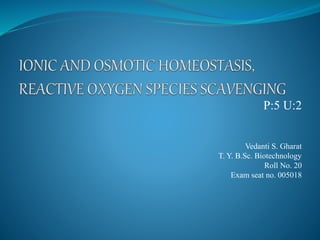
IONIC AND OSMOTIC HOMEOSTASIS, REACTIVE OXYGEN SPECIES.pptx
- 1. P:5 U:2 Vedanti S. Gharat T. Y. B.Sc. Biotechnology Roll No. 20 Exam seat no. 005018
- 2. IONIC HOMEOSTASIS IN PLANT STRESS AND DEVELOPMENT Ion homeostasis is a dynamic process and a fundamental requirement for all organisms. All living organisms have developed efficient systems to acquire and store elements and maintain their cytosolic and organellar concentrations within a specific physiological range that allows for normal development. The presence of high ionic concentrations in soil, especially of sodium chloride, is a great problem for the plant's physiology. Salt tolerance may be a macro evolutionary self-destructive trait, as it is gained frequently, but also is lost easily by reversal or extinction. This is probably due to the high amount of energy required to maintain the ion homeostasis under stress conditions, which hampers normal plant development.
- 3. Ion homeostasis determines pivotal functions such as the compensation of the negative charges of macromolecules, maintenance of electroneutrality, and the establishment of cell turgor and volume. Ions are also essential components of biomolecules, such as chlorophyll or hemoglobin, and they play a key role such as stomatal aperture which controls transpirational water loss, plant desiccation and cell elongation. In addition to direct effects of ions on plant cell physiological function and homeostasis, a proper membrane potential (inside negative) is maintained through the maintenance of specific cation and anion gradients across the cell membrane.
- 4. ION HOMEOSTASIS UNDER DROUGHT STRESS The problem is increasing due to the rising water demand to feed a growing population and the effects of climate change, especially in drought-prone arid and semi-arid areas. In response to drought, plants activate a defense mechanism devoted to the accumulation of water and potassium. High activity of K+ and Cl− uptake systems and a large root system are desirable traits. In the leaf, K+ and Cl− allow for an efficient osmotic adjustment of leaf cells, which is a key process to retain water within cells. Efficient stomatal closure prevents excessive water loss and is achieved by K+ and Cl− release from guard cells.
- 6. OSMOTIC HOMEOSTASIS Osmotic stress apparently reduces growth and productivity of crop plants. One important response to osmotic stress is the accumulation of the phytohormone abscisic acid (ABA), which induces several responses to osmotic stress. Osmotic stress signaling consists of an ABA-dependent and an ABA-independent pathway. Osmotic stress also caused increased ROS generation, which in turn elicits various cellular signaling networks resulting into physiological damage to plant cell.
- 7. Osmotic adjustment of cells helps maintain plant water balance As the soil dries, its matric potential becomes more negative. Plants can continue to absorb water only as long as their water potential is lower (more negative) than that of the soil water. Osmotic adjustment, or accumulation of solutes by cells, is a process by which water potential can be decreased without an accompanying decrease in turgor or decrease in cell volume. Osmotic Stress Induces Crassulacean Acid Metabolism in Some Plants Crassulacean acid metabolism (CAM) is a plant adaptation in which stomata open at night and close during the day.
- 8. Osmotic Stress Changes Gene Expression Several genes coding for enzymes associated with osmotic adjustment are turned on (up-regulated) by osmotic stress and/or salinity, and cold stress. Several other genes that encode well-known enzymes are induced by osmotic stress.
- 9. REACTIVE OXYGEN SPECIES SCAVENGING Induced osmotic stress resulted in overproduction of reactive oxygen species (ROS) which was considered as a hallmark of plant stress response. To scavenge the toxic consequences of ROS, plant deploys antioxidative mechanisms. Reactive oxygen species (ROS) were initially recognized as toxic by-products of aerobic metabolism. ROS plays an important signaling role in plants, controlling processes such as growth, development and especially response to biotic and abiotic environmental stimuli. The major members of the ROS family include free radicals like O•− 2, OH• and non- radicals like H2O2 and 1O2. The ROS production in plants is mainly localized in the chloroplast, mitochondria and peroxisomes. There are secondary sites as well like the endoplasmic reticulum, cell membrane, cell wall and the apoplast.
- 10. The cellular damages are manifested in the form of degradation of biomolecules like pigments, proteins, lipids, carbohydrates, and DNA, which ultimately combine in plant cellular death. To ensure survival, plants have developed efficient antioxidant machinery having two arms (i) enzymatic components like superoxide dismutase (SOD), catalase (CAT), ascorbate peroxidase (APX), guaiacol peroxidase (GPX), glutathione reductase (GR), monodehydroascorbate reductase (MDHAR), and dehydroascorbate reductase (DHAR); (ii) non-enzymatic antioxidants like ascorbic acid (AA), reduced glutathione (GSH), α-tocopherol, carotenoids, flavonoids, and the osmolyte proline. These two components work hand in hand to scavenge ROS.
- 11. REACTIVE OXYGEN SPECIES (ROS) ARE SYNTHESIZED IN TWO MECHANISMS The synthesis of ROS during the oxidative burst involves at least two separate mechanisms: NADPH oxidase and extracellular peroxidases. The plasma membrane- spanning NADPH oxidase transfers an electron from NADPH within the cell across the plasma membrane and uses this to convert extracellular oxygen to the superoxide anion (O2).The superoxide anions are then rapidly converted to hydrogen peroxide (H2O2). Two extracellular (apoplastic) peroxidase enzymes (PRX) are also sources of ROS production leading to the arrest of pathogen growth. The ROS generated by the extracellular peroxidases likely have roles as antimicrobial agents and in crosslinking specific polymers to the cell wall to improve rigidity.
- 12. REFERENCE Ion Homeostasis in Plant Stress and Development by https://www.frontiersin.org/ Reactive oxygen species scavenging mechanisms associated with polyethylene glycol mediated osmotic stress tolerance in Chinese potato by https://www.nature.com/ Plant physiology by Taiz and Ziegler book. Plant stress biology notes. Images were taken from google.